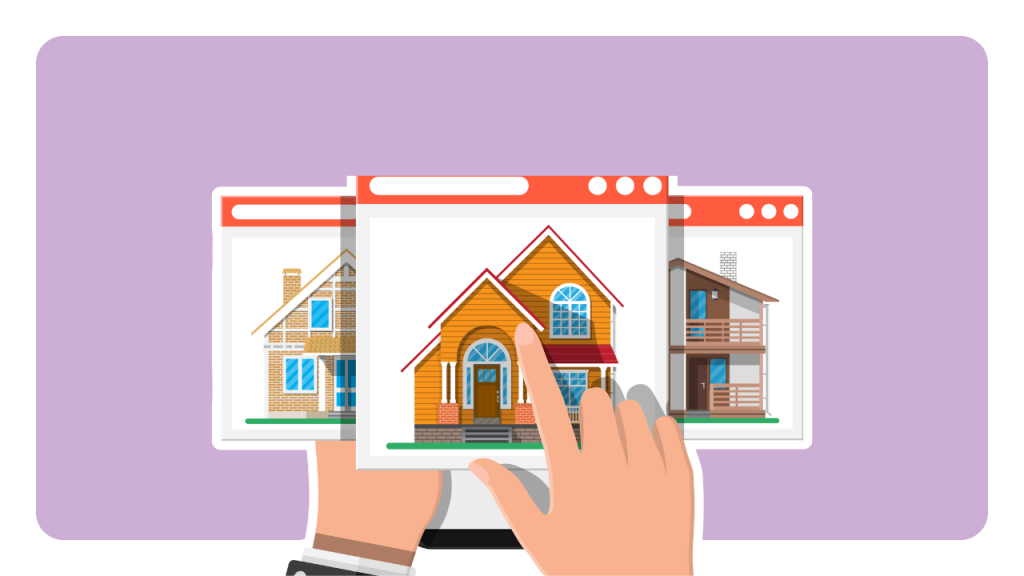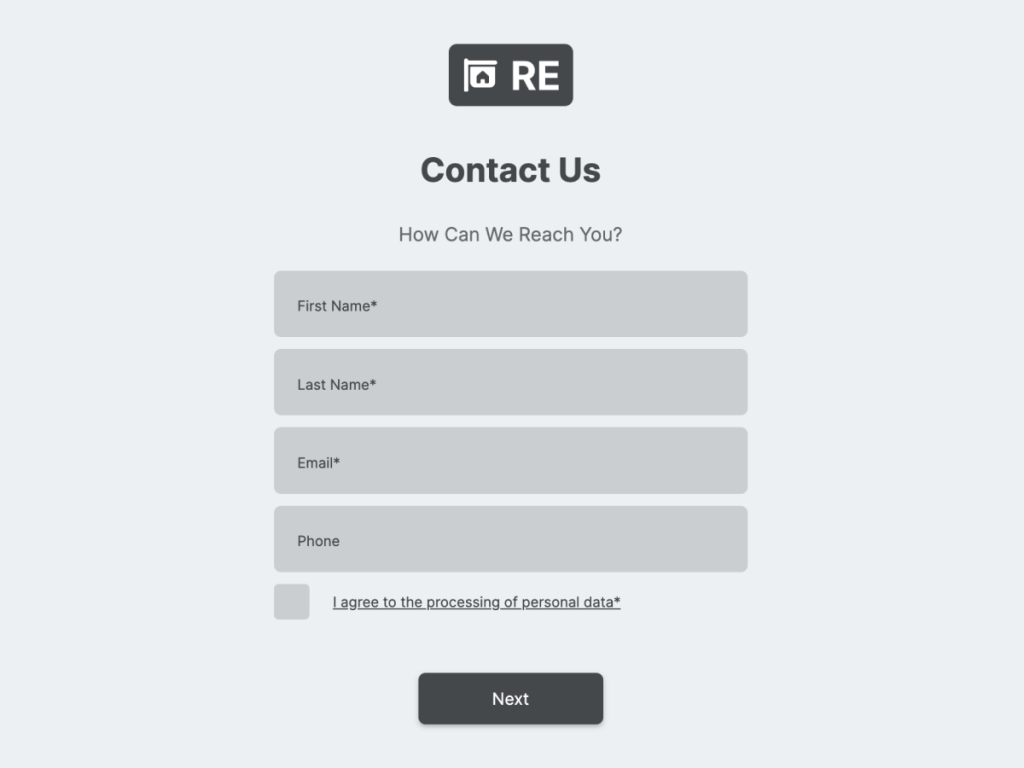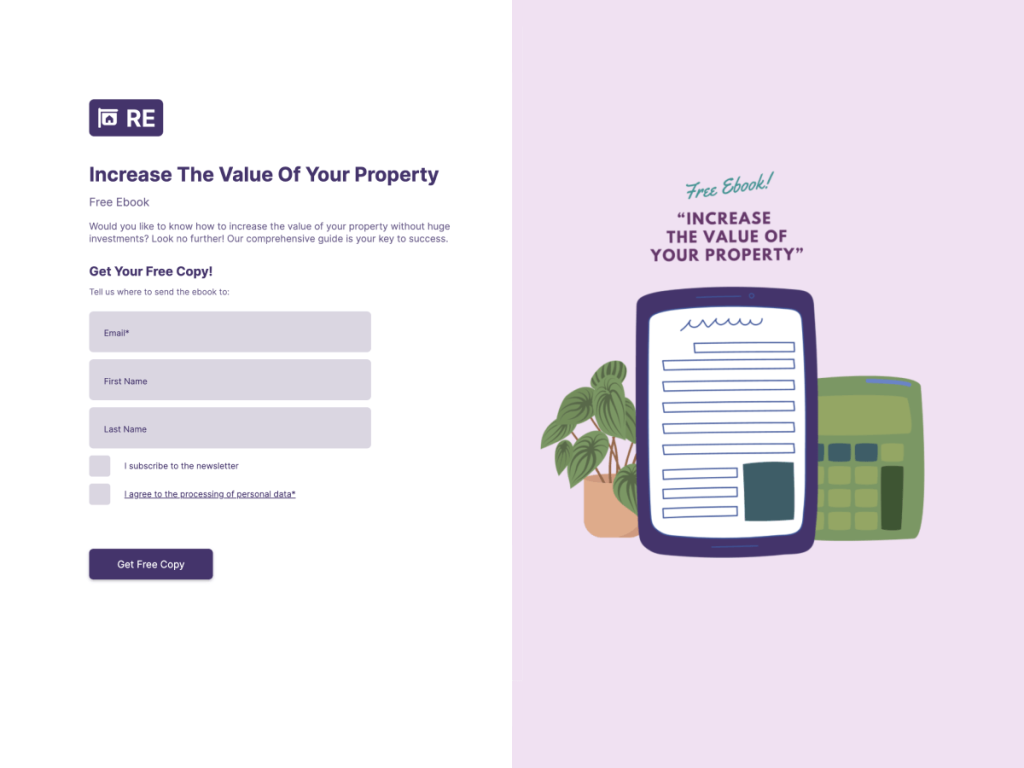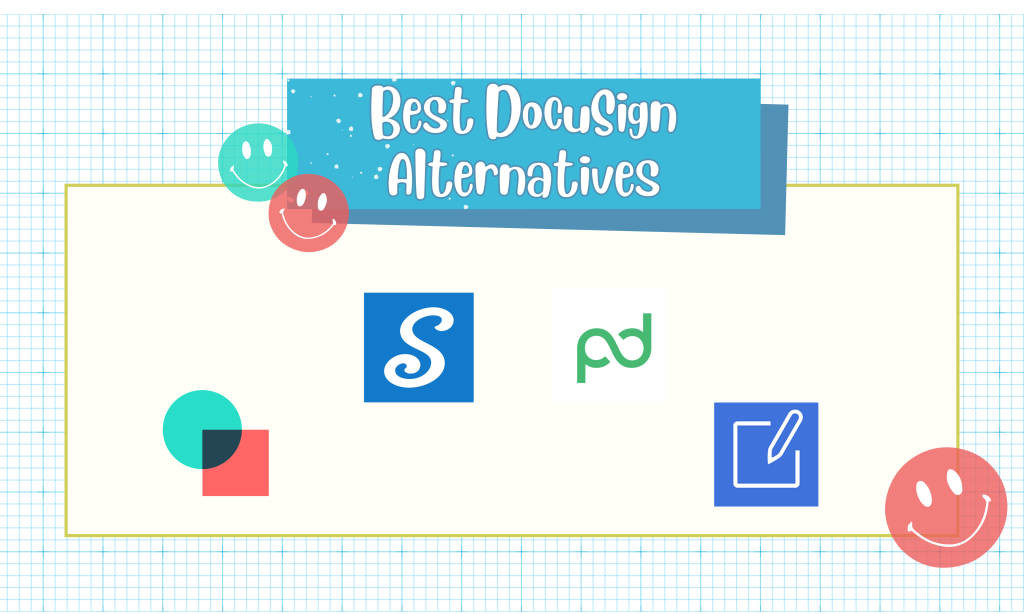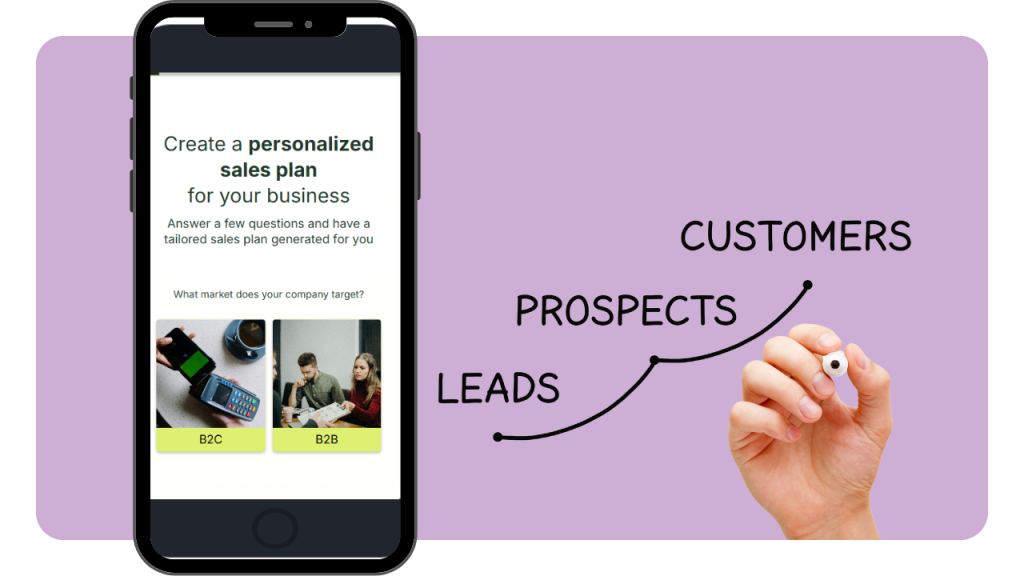The real estate market is competitive, and every click on your website counts. Instead of sending potential buyers and sellers to a generic homepage, smart agents use real estate landing pages designed with one goal in mind: capturing leads. In fact, landing pages are one of the most effective tools for online lead generation, giving agents a direct way to turn traffic into clients.
In this article, we’ll look at real estate agent landing page examples, highlight what makes them work, and share practical tips to help you build pages that drive results.
What Is a Real Estate Landing Page?
A real estate landing page is a single web page created to get leads. This page focuses on asking visitors to sign up for a home valuation, book a showing, or download a guide.
This makes it different from a homepage, which tries to cover everything about your business, or a property listing page, which only shows details about one home. A landing page removes distractions so visitors are more likely to take the action you want.
In the sales process, landing pages play an important role. They capture contact details from people who click on your ads, emails, or social media posts, and move them one step closer to becoming actual clients.
Why Real Estate Professionals Need Landing Pages
Landing pages are a must for real estate agents and agencies. Here’s why:
Build trust and credibility instantly
A clean, professional page with testimonials, certifications, or success stories helps visitors feel confident about working with you.Capture qualified leads
Whether it’s buyers looking for homes, sellers curious about their property value, or renters searching for options, a landing page filters out casual browsers and collects details from people who are serious.Showcase listings or free resources
You can dedicate a landing page to a single property, an open house event, or even a free download like a neighborhood guide or homebuyer checklist.Improve ad campaign ROI
Running Google or Facebook ads? Sending clicks to a focused landing page instead of your homepage increases the chance that visitors will take action, giving you more leads for the same budget.
Key Elements of a High-Converting Real Estate Landing Page
A great-looking landing page is only half the job, the real goal is to convert visitors into leads.
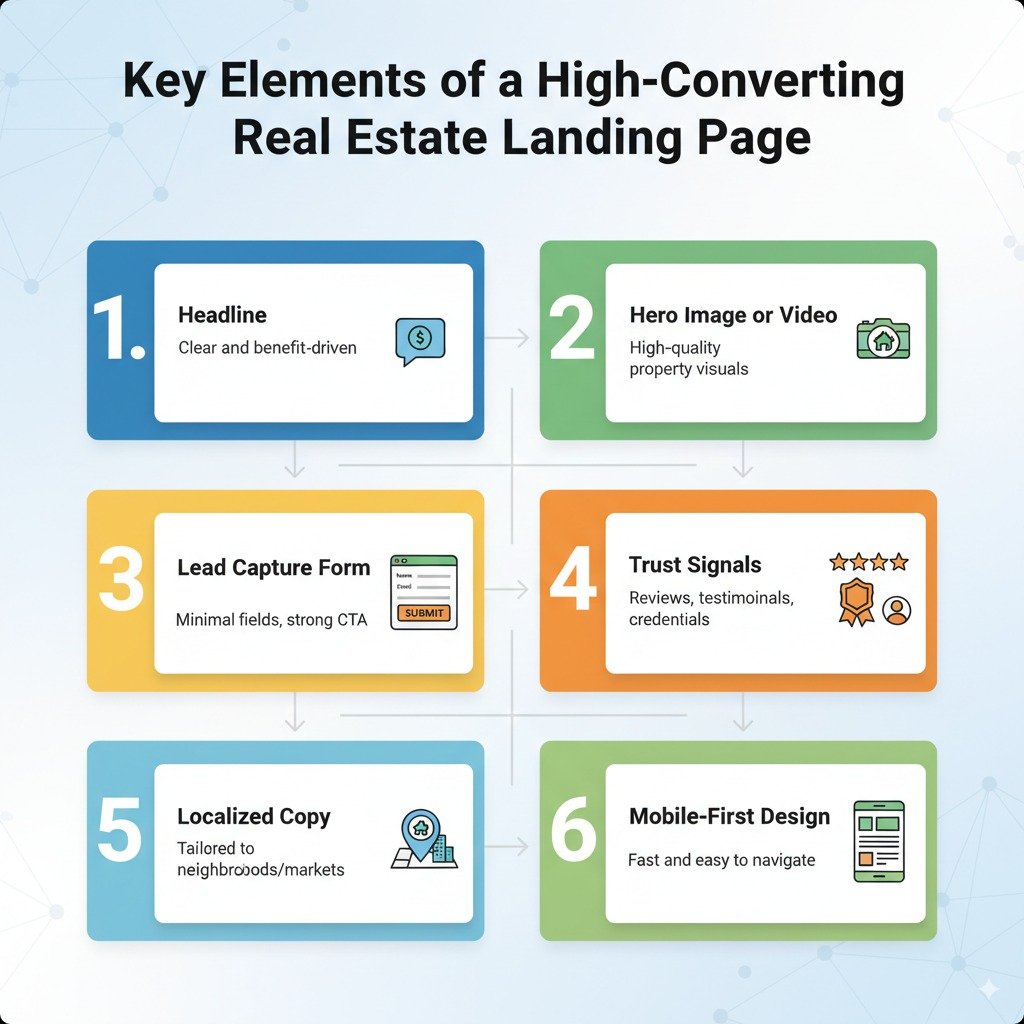
Here are the essential elements that make a real estate landing page work, along with examples of how agents and agencies use them:
1. Headline: Clear and benefit-driven
Your headline is the first thing visitors see, so it needs to tell them exactly what they’ll get. Instead of something vague like “Welcome to XYZ Realty”, use benefit-focused headlines such as:
“Get Your Free Home Valuation in Under 60 Seconds”
“See Homes for Sale in [City] Before They Hit the Market”
“Find Out What Your [Neighborhood] Home Is Really Worth”
A real estate agent landing page offering a free valuation with a headline like “What’s Your Home Worth in Denver Today?” is far more likely to capture attention than a generic agency slogan.
2. Hero Image or Video: High-quality property visuals
Real estate is visual, so strong imagery is non-negotiable. Use:
Professional property photos
A short video walkthrough
A lifestyle image (e.g., a family in their new home)
For example, an agent promoting a luxury condo should showcase sweeping interior shots or a drone view of the neighborhood. These visuals help potential buyers or sellers picture themselves in the space, and trust the professionalism of the agent.
3. Lead Capture Form: Minimal fields, strong CTA
The form is the heart of your landing page. Keep it simple: usually name, email, and phone number are enough. The fewer fields, the higher the conversion rate. Pair this with a clear, action-focused button such as:
“Book My Showing”
“Get My Free Report”
“See Listings Now”
For instance, a seller-focused landing page with the form headline “Find Out Your Home’s Value in 30 Seconds” and a button that says “Show My Home Value” feels easy and low-commitment, making users more likely to fill it out.
4. Trust Signals: Reviews, testimonials, credentials
Since real estate is a high-trust business, visitors need reassurance before sharing their details. You can add:
Client testimonials with names/photos
Star ratings or review badges (Zillow, Google Reviews, etc.)
“Licensed in [State]” or association memberships (NAR, MLS logos)
For example, one high-converting real estate agent landing page features a headline offering a free valuation, followed by a short testimonial: “John helped us sell our home in under 2 weeks at 15% above asking. Highly recommend!” This builds instant credibility.
5. Localized Copy: Tailored to neighborhoods/markets
Generic copy won’t work in real estate. People want to know you understand their market. Mention city names, neighborhoods, schools, or even specific streets when possible.
Buyer page: “Browse homes for sale in Uptown Dallas with private backyard pools.”
Seller page: “See recent home sales in Queens, NY to know what your house is worth today.”
A landing page that says “Get Your Free [San Diego] Home Report” feels more relevant than a broad “Free Home Report Anywhere.”
6. Mobile-First Design: Fast and easy to navigate
Over half of home searches now start on mobile devices. If your landing page doesn’t load fast or looks messy on a phone, you’ll lose leads instantly. Key practices include:
Simple layouts with large buttons
Short forms that fit on one screen
Fast-loading images
For example, an agent running Facebook ads for first-time buyers should ensure that when users click, the mobile version of the landing page loads in seconds and displays the form at the top.
Real Estate Landing Page Examples That Actually Convert
Here are real estate landing page examples explained and reasons why they work:
1. Keri Shull Team Landing Page
This page is built for both buyers and sellers, offering two clear paths: “Search Homes” or “Get Your Home Valuation.” It uses strong CTAs, social proof from past clients, and highlights the team’s track record.
Why it works: It instantly speaks to two different audience types, keeps the choices simple, and builds trust through testimonials.
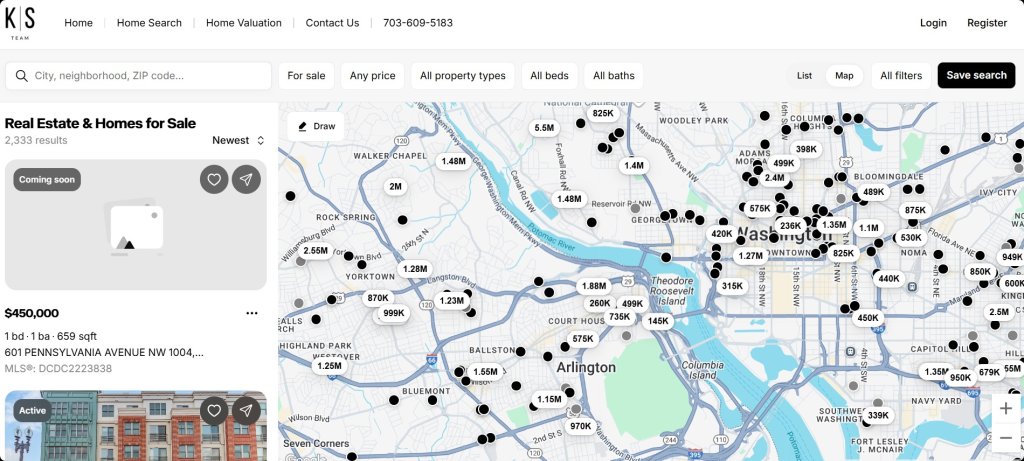
2. Realtor.com Buyer Landing Page
Realtor.com’s search-focused landing experience lets users immediately enter a city, ZIP code, or neighborhood to find homes. The clean design keeps the visitor focused on property search.
Why it works: Visitors know exactly what to do the moment they land, type in a location and start browsing. No distractions, no confusion.
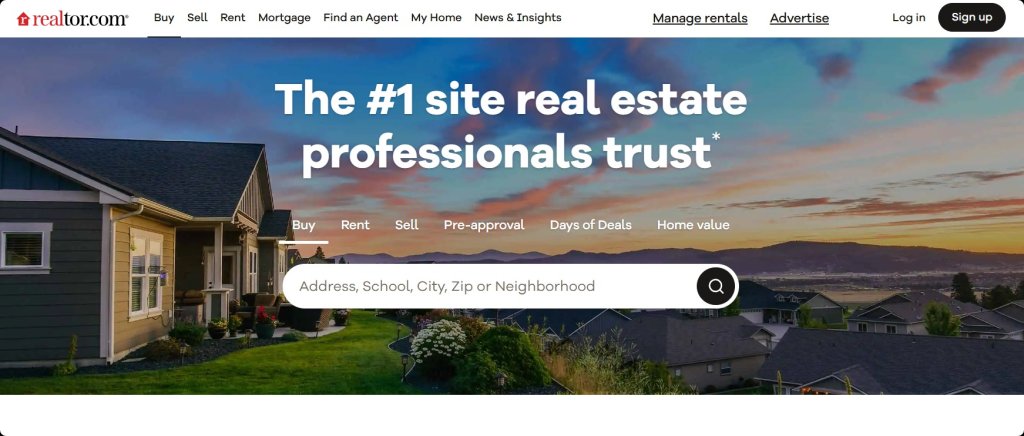
3. Douglas Elliman “Sell With Us” Page
Douglas Elliman uses a seller-focused landing page with a clear offer: get a property valuation. The page includes market insights, credibility stats, and a simple form.
Why it works: It addresses seller pain points directly, uncertainty about value, and combines this with professional branding and trust signals.

4. Sotheby’s International Realty Niche Landing Pages
Sotheby’s creates specific landing pages for luxury categories like beachfront homes, mountain estates, or penthouses. The visuals are striking, and the messaging is tailored to exclusivity.
Why it works: By segmenting audiences and using aspirational imagery, Sotheby’s speaks directly to high-net-worth buyers looking for niche properties.
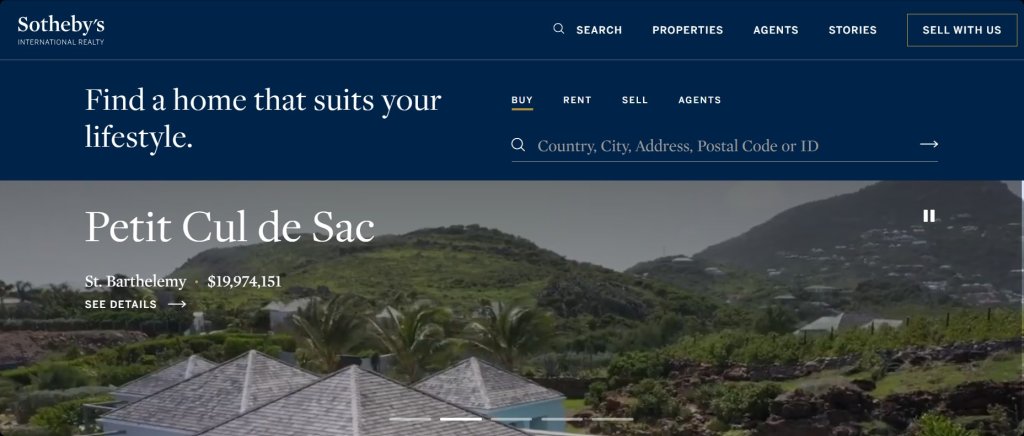
5. Redfin Concierge Service Page
Redfin’s concierge service landing page highlights an offer for sellers who want help preparing homes for sale. It reassures users with a no-upfront-cost promise and strong CTAs.
Why it works: It removes friction for hesitant sellers by addressing fears upfront and focusing on the value of the service.
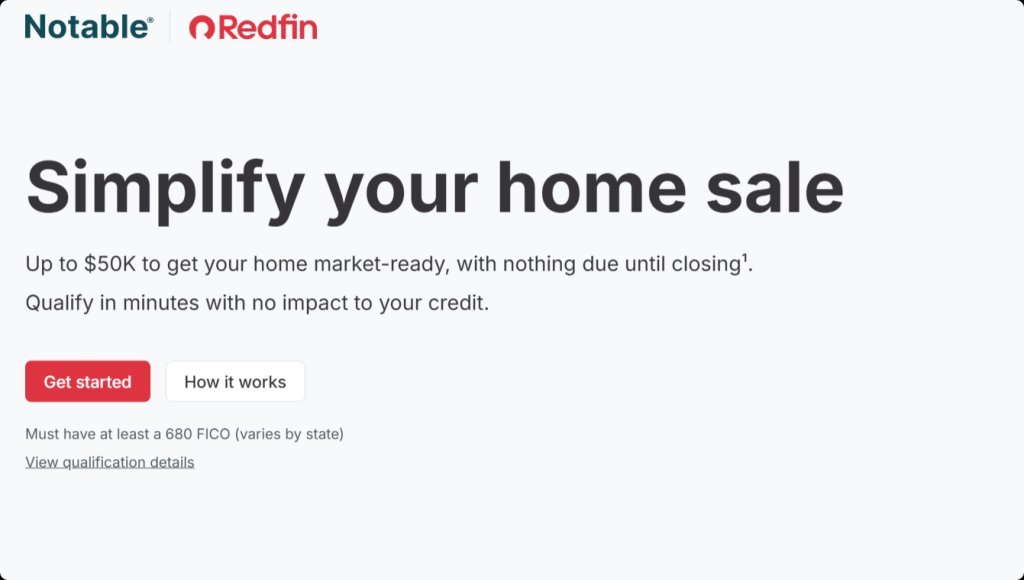
6. SERHANT Real Estate Landing Page
SERHANT’s page mixes property search with branding and credibility (press mentions, founder Ryan Serhant’s visibility). It combines sleek design with listings upfront.
Why it works: Visitors can start searching immediately while being reassured by the agency’s authority and reputation.
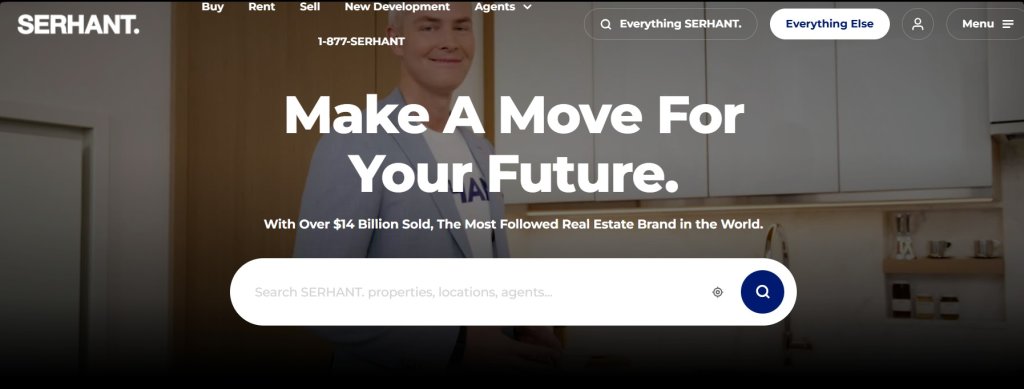
7. The Agency Real Estate Page
This landing page gives visitors three quick options: buy, sell, or rent. It highlights featured listings, shows media mentions, and builds credibility through brand design.
Why it works: By letting users self-select their path quickly, it minimizes bounce rates and improves lead quality.
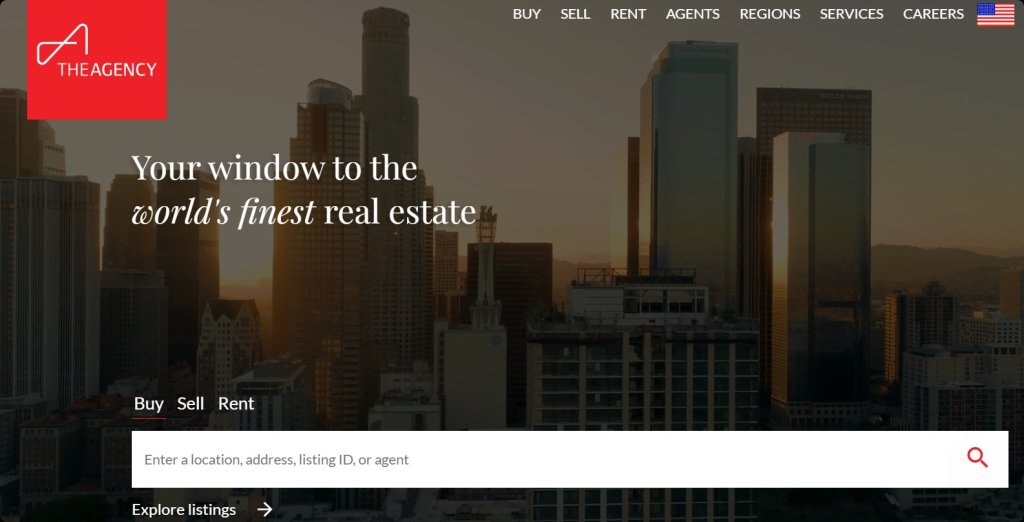
8. Joy Bolger Agent Landing Page
Joy Bolger’s landing page emphasizes her personal brand, showcasing testimonials, a clear service description, and a prominent contact form.
Why it works: It’s highly personal, making it easy for potential clients to connect directly with the agent rather than a faceless brokerage.

Tips to Create Your Own Real Estate Agent Landing Page
Building a landing page doesn’t have to be complicated. With the right tools and approach, even agents without coding or design experience can create pages that look professional and convert well. Here are some actionable tips:
1. Use templates to save time
You don’t need to start from scratch. Platforms like involve.me offer ready-made real estate landing page templates to help you create landing pages that you can customize with your own branding, copy, and visuals.
Create Your Own Landing pages
Get Started with 350+ Templates
You can also use involve.me AI agent to create landing page instantly. This is especially helpful if you need multiple landing pages, for example, one for buyers, one for sellers, and one for open house signups.
Give our AI Agent a try, it's free!
2. Test different CTAs
Your call-to-action (CTA) button can make or break conversions. Instead of sticking with a generic “Submit,” try wording that’s specific and appealing:
Buyer page: “See Homes in My Area”
Seller page: “Get My Free Home Value Report”
Open house page: “Save My Spot”
A small change in CTA text can significantly improve conversion rates.
3. Personalize copy to local neighborhoods
Real estate is hyper-local. Instead of broad phrases like “Find Homes Today,” call out specific markets:
“See condos for sale in Downtown Miami”
“Check what homes in Scottsdale sold for this month”
This level of personalization shows visitors you know their area and makes the page feel more relevant.
4. Add urgency
People act faster when there’s a sense of urgency. You can add urgency by:
Highlighting limited-time offers (e.g., “Free Home Valuation This Month Only”)
Featuring properties that are in demand (e.g., “Homes in [Neighborhood] Under $300K – Selling Fast”)
Using countdown timers for open house sign-ups or promotions
5. Run A/B tests
Don’t assume your first landing page is perfect. Run A/B tests where you change one element at a time like the headline, form placement, or background image and see which version gets more leads. Over time, these small improvements add up to much higher conversion rates.
Best Practices for Optimizing Real Estate Landing Pages
Once your landing page is live, the next step is optimization. Following best practices ensures your page isn’t just functional but consistently high-performing:
1. Keep forms short
Asking for too much upfront scares people away. Limit your form fields to the basics, usually name, email, and phone number. If you need more details later, collect them during follow-up.
2. Highlight one main CTA
Avoid overwhelming visitors with too many choices. A high-converting page usually has one clear call-to-action, such as “Get My Free Report.” Multiple CTAs (like “Contact Us,” “Book Now,” “See Listings”) can create confusion and lower conversions.
3. Use strong visuals
Real estate is highly visual, so showcase your properties with professional photos and, when possible, short video tours. Lifestyle images like a family in front of their new home, also work well for building emotional connection.
4. Optimize for SEO
While most landing page traffic comes from ads, don’t ignore organic search. Use target keywords like “landing pages for real estate” and “real estate agent landing page” in your headline, subheadings, and meta description. This helps your page rank in search engines and brings in free leads.
5. Track performance
Use analytics tools to measure how well your landing page performs. Focus on:
Conversion rate: The percentage of visitors who fill out the form
Lead quality: Are they serious buyers/sellers or just browsing?
Traffic sources: Which ads, emails, or social channels bring the best leads
Regular tracking helps you double down on what’s working and cut out what’s not.
Common Mistakes to Avoid
Even experienced agents sometimes fall into traps that keep their landing pages from performing well. Here are the most common mistakes to watch out for:
1. Using a homepage instead of a landing page
Sending ad traffic to your homepage is one of the biggest mistakes. Homepages are full of links and distractions, which means visitors are more likely to leave without taking action. A dedicated landing page keeps the focus on one goal: capturing leads.
2. Asking for too much info upfront
Forms with too many fields like full address, budget, or financing status, scare people away. At the first stage, only ask for essentials such as name, email, and phone. You can always gather more details later once trust is built.
3. Weak or generic headlines
A headline like “Welcome to ABC Realty” doesn’t give visitors a reason to stay. Instead, use benefit-driven headlines like “See Homes in [City] Before They Hit the Market” or “Find Out What Your Home Is Worth Today.”
4. Not mobile-optimized
With most people browsing properties on their phones, a slow or cluttered mobile page kills conversions. Always test your landing page on different devices to make sure it loads quickly and looks professional on smaller screens.
5. Forgetting follow-up automation
Capturing leads is only the first step. If those leads don’t get an immediate follow-up, they often go cold. Connect your landing page to a CRM or email marketing tool so every new contact gets an instant response whether it’s a thank-you email, a scheduling link, or more property details.
Final Words
A real estate landing page isn’t just about looking polished, it’s about turning visitors into leads. By focusing on clear headlines, strong visuals, short forms, and trust-building elements, you can create pages that consistently bring in new clients.
The key is to test, optimize, and learn from real examples. Small tweaks like changing your CTA text, adding a testimonial, or improving mobile speed can make a big difference in your results.
Start building your own high-converting real estate landing page today, and turn more browsers into buyers, sellers, and long-term clients.
Create a landing page in minutes
No coding, no hassle, just better conversions.

